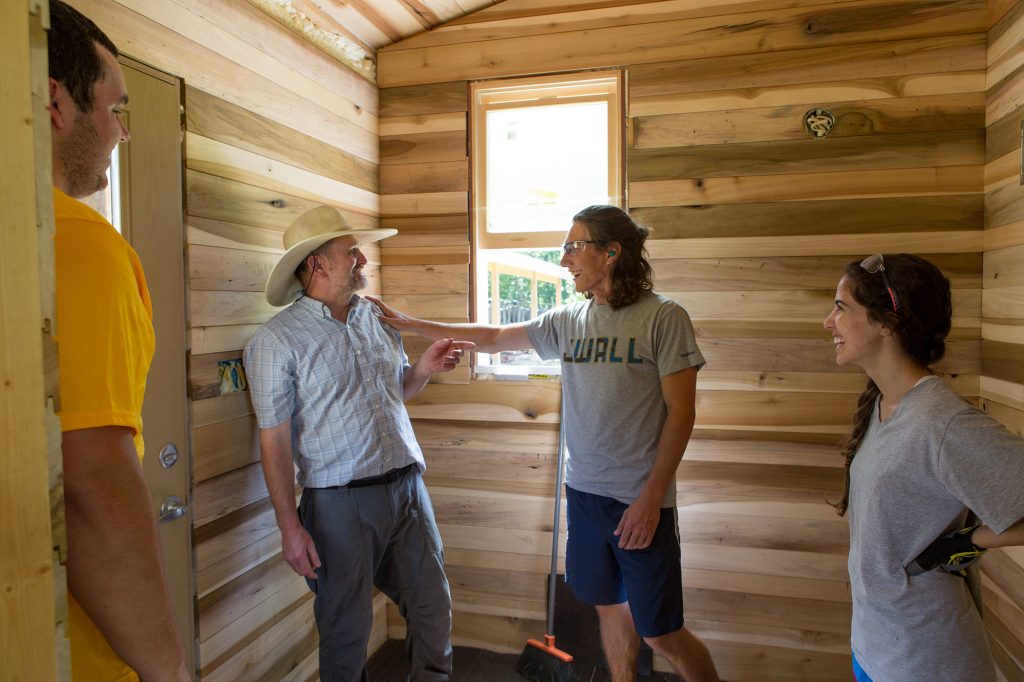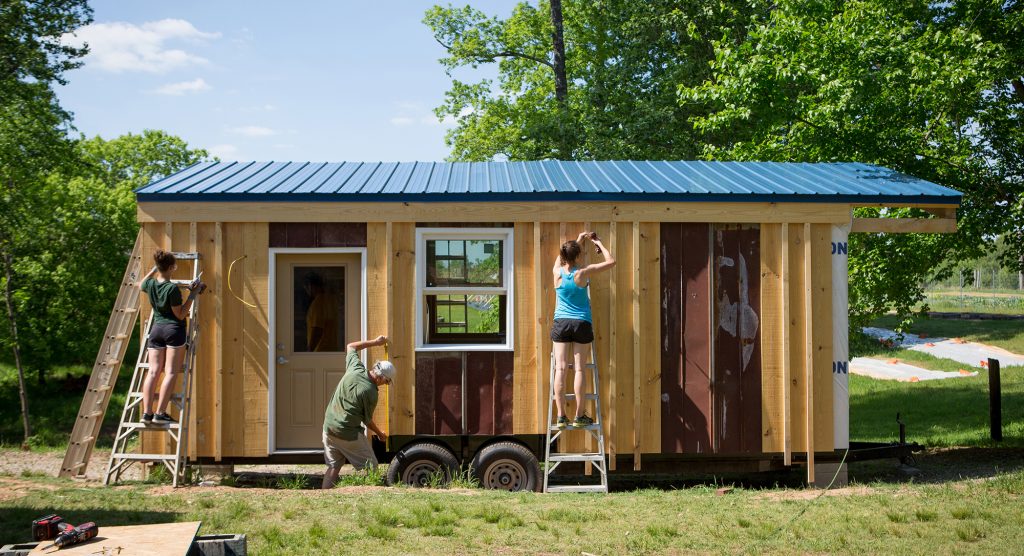The Tiny House Movement

A “Penchant for Fantasy” or a Movement?
by Cynthia Adams | Photos By: Nancy Evelyn
The tiny house movement defies easy description. Just ask a sociologist.
When Joel Stillerman, author of “The Sociology of Consumption,” discussed minimalism in a recent interview with the New York Times, he made a thought-provoking analysis. He suggested a counterintuitive kind of affluence at work with all things minimalist.
Minimalism is chic: the Armani of decor, an emblem of refinement for museum rats. Minimalists, curating their homes to reflect deliberate restraint, were definitely a part of social change—but not quite the one Millennials embraced. “These people,” Stillerman said, “are making the statement that ‘I can afford to have less. I appreciate books and travel and good meals.’”
Even so, minimalism is a significant put-down of bloat: an ashtray must be pondered. How many immaculate white shirts should hang in the closet?
Minimalism of any type is a big pronouncement, one that nails a decree on the door. It begs the question of us: is more, or bigger, better?
For a growing number of first-time homebuyers, retirees, vacationers and deliberating consumers, the answer is no. With the statistical help of the U.S. Census Bureau, we glimpse why many wish to opt out of the norm. The average square footage of a home is nearing 3,000 square feet with a price tag of $300,000. Contrast that with a tiny house, which is less than 500 square feet, with materials costing as little as $25,000. Sweat equity versus a 30-year mortgage means another life experience.
Less-is-more advocates say that smaller is snug, smart and even sensationally affordable. Tired of excess, unused rooms, storage units bursting with detritus, and basements full of moldering mystery boxes, there is a movement afoot to promote downsizing.
The housing statistics cited by UGA assistant professor Kimberly Skobba in the Housing Management and Policy Program are arresting. Consider space and the energy footprint of conventional housing. With the average square footage of the American home leaping from 1,000 square feet in 1950 to nearly 3,000 square feet in 2015, conspicuous consumption expanded exponentially. (The largest increase occurred between 1973 and 2017.) Post-recession, the square footage began increasing apace in 2011, and 41 percent of homes had more than four bedrooms by 2012.
With a tiny home, there is a radical lowering of energy costs: cooling and heating a few hundred square feet is vastly different. A tiny structure can be heated with a wood stove. Some go off the grid entirely.
Skobba and David Berle, a professor of horticulture, have taught tiny house classes for several years, combining service learning with social action initiatives. “The tiny houses we build are done so in partnership with Georgia Organics to support housing needs of owners, managers, and interns on small organic farms in Georgia,” says Skobba. The professors teach via hands-on construction of a 150 square foot tiny house, combining experience with traditional lectures. Students maintain a blog: www.tinydawghouse.com. In a lecture offered last November, Skobba said they also offer instruction in “green building light.”
This spring, the class, which met twice weekly, attracted keen interest.
“It challenges housing space norms,” said Skobba. “Students often take the class because they have a fascination with tiny houses. Most leave the class realizing that even if a tiny house isn’t in their future, they would like to be more intentional about the size of and types of spaces within their future homes.”
Tiny houses—whether tree houses, converted shipping containers, or even wee micro pods—have seized the television airways and the imagination of HGTV viewers and aspirants, eager to watch how to shoehorn a life into very little space. Popular TV shows depict what it means to live in 1,000, 500, 400, or even fewer square feet.
The sheer smallness of scale inspires wonder. Perspective is everything. So is a commitment to social action as Skobba suggests by embracing a more conscious form of consumerism when she lectures publicly on the wildly popular topic.
And yet, despite this popularity, municipal zoning laws do not always share an enthusiasm for tiny residences. In Athens, Ga. for example, zoning requires a minimum of 1,000 square feet for residential homes. Some towns are more accepting of tiny homes, but not all.
In some areas, strictly enforced zoning restrictions have prompted wanna-be-tiny homeowners to do a work around, building a cross-hybrid in their own back yard in order to circumvent restrictions.
There are various ploys to help tiny home owners wiggle around zoning. If a tiny residence is built on pontoons, or an axle, or a boat trailer for example—in other words, if the structure can be towed—then owners can circumnavigate tougher zoning restrictions.
For example, advocate John Williams who lives in the Piedmont area of NC, is a master navigator of zoning. He insists that a house built upon a pontoon is technically still a boat. That boat can remain in your yard or driveway—and isn’t subject to standard zoning laws.
“If you have a trailer or RV, you can remodel it. It’s still an RV,” explains Williams, who is also the owner of Camp Tiny House of the Triad NC. He is a tiny house aficionado and retired educator who grew up in Iowa and now lectures throughout the Southeast on tiny houses and quirky conversions.
A 40 foot long converted school bus is also exempt from code, he says. So, Williams built a deck above to extend the living area of one, but it is still “a bus conversion with a top deck.” Otherwise, tiny home builders have to meet all the code regulations applying to site-built homes.
Some want a smaller home near their children. Others want to retire in place in a tiny home. Others simply enjoy the whimsy.
“The little kid is coming out, building these spaces and places.” William smiles. This seems especially true when it comes to adults building tree houses as alternative dwellings.
Consider this: the most popular Airbnb listing of all time is a minimalist tree house inside the city of Atlanta, Ga. The rustic fantasy tree house is a standout, quaintly built with a Swiss Family Robinson appeal. It appears at the top of Airbnb clients’ wish lists. Airbnb says the reason is simply this: that tree houses speak to those with a “penchant for fantasy.”
Tree houses are also a topic that is subject to interpretation, and planning departments may or may not submit them to stricter scrutiny. Smaller ones are usually acceptable, according to Williams. Yet some larger tree houses fall under ordinary zoning codes and are subject to city inspection.
Then there is the matter of costs, which can be radically different, especially given finishes and appliances. Tumbleweed tiny houses—the winsome cottages frequently posted on Pinterest’s website—cost approximately $20,000 and up if finished with upcycled and recycled materials.
A container conversion, fashioned from a shipping container, costs $5,000 and upwards depending upon the finishes and refinements. Fabricators can cut windows and doorways into containers in order to make them home-like and less boxy. Yet there is another option, one which is small yet means affordable housing for some who are priced out of the conventional market: micro pods.
Micro pods are what Williams terms as anything from a “little sleep cube to a shed.”
Sleep cubes? Sheds? Sure, he told a group of retirees at a public garden event in NC. “You can build something small and very entertaining for about $3,000.”
Tiny homes represent an affordable and healthy option for those who are unwilling (or unable?) to support unsustainable building. Skobba says in her lectures that “Many people are in bigger homes than they can afford. For retirees and millennials, tiny houses provide an affordable alternative to rental housing and homeownership—both of which are increasingly out of reach for American households.”
A home for $3,000 is a very big idea: Think small. Then think smaller.











